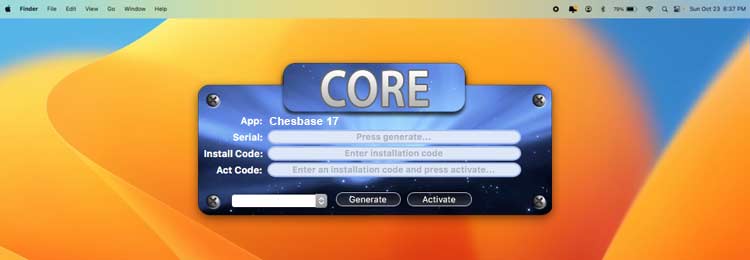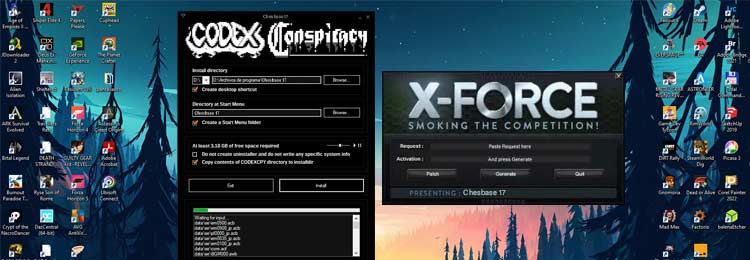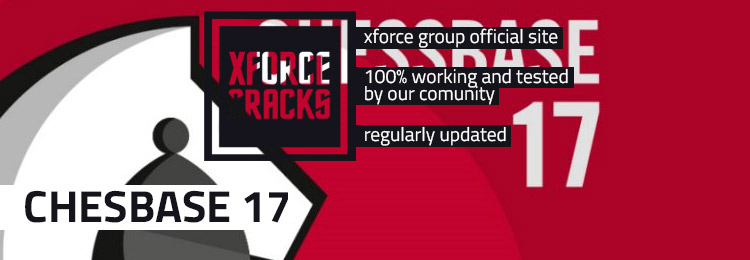Hello friends, great news! Here we bring you the latest version of the new Chessbase 17 crack patch created by the people at CODEXCPY, CORE and our friends of XFORCE.
This version is a simplified version of PainteR group’s “universal patcher” but much easier to install.
It is very simple to install: just follow the steps of the installer and finally mount the .iso image and run setup.exe as shown in the video tutorial. It only has an advertisement, if you want to avoid advertising you can register in the forum and download and install it from there. Any questions can be asked in the forum directly to its authors. Thank you for your continued support!
Download our Chessbase 17 crack-patch
Release Date: 8/4/2024 (Latest Windows version)
We kindly ask that you pass by a small ad to keep this website and forum up and running =)
Download CORE-KEYGEN Chessbase 17 for mac
Release Date: 8/4/2024 (Latest macOS version)
We kindly ask that you pass by a small ad to keep this website and forum up and running =)
Chessbase 17, Keygen & Crack
Keygen Version: v1.23.21
Release Date: 8/4/2024
Compatible with:
Microsoft® Windows® 11 or Windows 10 version 1809 or above
Apple® macOS® Monterey v12, Apple macOS Big Sur v11, Apple macOS Catalina v10.15
net framework 4.5 needed
Cracked by codexcpy.com & xforce-cacks.com


Exploring the Features and Benefits of ChessBase 17
If you’re familiar with the world of professional chess, you’ve likely heard of ChessBase, a highly-regarded software among top players. ChessBase allows users to store games in databases, analyze them, add comments, and search for games played by themselves and countless other players.
The first iteration, ChessBase 1.0, debuted in 1987, and the software has evolved significantly since then, with ChessBase 17 being the latest version. A common question among my readers is whether investing in ChessBase 17 is worthwhile. In this article, I will outline the advantages and disadvantages of ChessBase to help you decide if it suits your needs.
If you want to know how to prepare against a specific opponent using ChessBase, check out my comprehensive step-by-step guide here.
Who Should Use ChessBase 17?
ChessBase 17 is designed primarily for advanced club players, masters, and professional chess players. Ask any Grandmaster about their preferred software, and they will almost certainly mention ChessBase. It is also widely used by professional coaches and authors who leverage its advanced features to find instructive positions and annotate games with various symbols.
If you’re looking for the best chess analysis software available, ChessBase 17 is the clear choice. However, it does come with a significant downside: the price. ChessBase 17 is quite expensive, and with regular updates, you may find yourself spending more money to stay current.
Understanding the Basics of ChessBase
Admittedly, technology isn’t my strong suit, and I was slow to adopt newer versions of ChessBase. Up until a year ago, I was still using ChessBase 11, released in 2010. I believed it met my needs, but as I collaborated with training partners, I noticed they were able to obtain information more quickly and draw conclusions faster than I could. They were using features available in the newer versions of ChessBase.
By not upgrading, I was missing out on valuable time-saving opportunities. Realizing this, I upgraded to ChessBase 16 last year and immediately saw a significant improvement. The lesson here is clear: when used correctly, technology can open up new opportunities, simplify tasks, and save time.
Now, let’s focus on ChessBase 17, the latest version that I’ve been using since the start of the year. While there are many new features, I will highlight the ones I find most useful.
The New Analysis Window
The analysis window in ChessBase 17 is the standout feature, packed with numerous enhancements. For those familiar with previous versions, the new features in this window are impressive:
- Coloured Hints: These highlight the most critical moves, indicating how the evaluation of the position changes between the best and second-best options. This color-coding provides instant insights into the position’s dynamics.
- Textual Explanations: Sometimes the software provides brief explanations or conclusions about the position, such as “White has a decisive advantage. Black loses a pawn.”
- Threat Indicators: Threats are marked in red, making it easier to understand the position’s nuances.
- Drag-and-Drop Variations: You can easily drag any variation shown by the module into the notation, along with the threats.
- Position Preview: Hovering the cursor over a point in the analysis module shows the highlighted position on the board.
- Visual Evaluation Panel: This panel uses fire emojis to indicate the position’s complexity and gear icons for the activity of each player’s pieces. Hovering over this panel lights up each piece on the board in color, reflecting how well or poorly placed they are. Pieces marked in red highlight weaknesses quickly.
Enhanced Features in ChessBase 17
The new search window in ChessBase 17 has been completely overhauled, offering numerous options that significantly streamline the search process. One of the standout features is the ‘fast search’ function, which eliminates the need to place all pieces of a position to find it.
The Search Window
To illustrate the power of this feature, let’s consider an example.
Suppose you want to find the game where Shirov won with his renowned …Bh3 move, but you can’t recall his opponent or any other specific details of the position—just that White could capture the bishop with a pawn.
First, you open the search panel and type ‘Sh’ in the ‘players’ field, and Shirov appears as the first option. Then, select ‘result’ and specify that Black won. Finally, in the ‘search by position’ section, place a white pawn on g2 and a black bishop on h3. That’s it!
Beauty Awards
One of the most enjoyable features in ChessBase 17 is the ability to award beauty medals to games in a database, based on sacrifices and tactical brilliance.
Naturally, I couldn’t resist testing this feature in my own games’ database.
Conclusion
ChessBase 17 introduces a host of new features that cater to all types of players, from enthusiastic amateurs to seasoned professionals. Technology, when used effectively, can enhance our capabilities and save us time. ChessBase 17 stands out as a leader in this regard, providing a comprehensive array of options and opportunities.
In the example image below, my database showed nine games where Shirov won with Black, had a bishop on h3, and there was a white pawn on g2. Simply pressing the search button brought up these nine games, making it easy to find the one I was looking for. It’s important to search in the correct database, such as MegaBase 2023 in my case.
Pricing of ChessBase 17
ChessBase 17 is the premier software in the chess world, used by countless professional players and club enthusiasts. It serves as a digital notebook, organizing all chess-related work: openings, game databases, analyses, master games, training positions, and more. This review is based on insights from FM Jorge Ramírez for the “Peón de Rey” magazine.
ChessBase 17 is available at different price points. The most affordable version costs 149 Euros (since the company is German, prices are in Euros). Over the past five years, the Euro has ranged between $1 and $1.10, so the price is approximately $149 to $164.
For the premium version, the cost is 499.90 Euros. Below, you can see the official pricing along with the additional perks, which I will explain further.
ChessBase, developed by a company of the same name, regularly releases new versions. ChessBase 17 is the latest as of this writing.
The primary use of ChessBase is organizing chess databases. I used the software from 2008 to 2021, until I retired from professional chess. Currently, I use a combination of ChessBase 16 and Lichess for coaching.
ChessBase 17 offers a multitude of features, but I primarily use three core functions:
- Creating and saving my own opening analysis in databases.
- Annotating and analyzing my games in one database.
- Preparing against specific opponents using the ‘Mega Database.’
Although I’m not a tech expert, I rarely use additional features like searching for positions with similar piece configurations or games with similar tactical patterns.
Having achieved Grandmaster status without relying heavily on these advanced features, I will focus on the three core functions mentioned above to help determine if ChessBase 17 is a good investment for you.
Primary Applications of ChessBase
If you’re interested in delving deeper into the game analysis process, this article is tailor-made for you.
Opponent Preparation
One of the key ways I utilized ChessBase was to prepare for future opponents. With the help of the Mega Database—a separate product by ChessBase that is often bundled with the main software—you can find and study your opponent’s games to strategize against them.
Furthermore, you can source games online from platforms like Opening Tree, download them, create a database, and prepare for these games using ChessBase.
The major benefit here is the ability to easily filter games by color, analyze performance metrics (highlighting strong and weak areas of your opponent), and identify when they last played a specific opening.
The user interface for game preparation in ChessBase is exceptionally intuitive and superior to anything else I’ve encountered.
Let me explain briefly how these use cases benefited me as a professional chess player.
Opening Databases
As you climb the rating ladder, opening analysis becomes increasingly critical.
Before the digital era, players would bring binders filled with handwritten opening notes to tournaments. They would then sift through these papers to find the most relevant openings for their next game and play them out on a physical board.
This entire process has been significantly simplified with opening databases. From the comfort of my home, I can analyze the latest opening ideas directly in ChessBase using an engine (mostly Stockfish) and a comprehensive database of recent games (either online or from the Mega Database).
For a detailed guide on setting up your opening analysis, you can read my article on the right opening analysis setup.
Once satisfied with my analysis, I save it in one of my databases (usually ‘White Repertoire’ and ‘Black Repertoire’) and label it for easy retrieval.
At a tournament, I can quickly access my White Repertoire Database, locate the file with the variation I expect to face, and review the work I did at home.
Game Annotation
If you’ve followed my articles, you know I strongly advocate for analyzing your own games. This was a process I rigorously followed using ChessBase. I maintained a database filled with files of my own games. After each game, I would meticulously enter all the moves into a new file and save it in the database.
We believe that cracking and sharing softwares is something great and needed, but please never forget to support his creators. If you can afford the product PLEASE buy it =)
*—————–* !!!!! Accept no imitation / X-FORCE * * We are the world #1 !!!!! *——————*
**********************************************************************************************************


thank you very much.
thnxxx!!!!
Super. Thank you…!
i cant dowload anything
On Mac OS Sierra the keygen is not opening. The system says “file cannot be open because not supported on this mac”
There is a patch but antivirus removes it constantly. Then Quattro pro doesn’t work anymore.
2020 is no longer available to d/l its 2021 now. Please advise as to workaround? TIA
Does this work for 1.9.4 version? Thank you
nice music lol thx
Remember the first version of this on DOS days on a 286… Wow.
how to download bro
Works great! Thanks!
thanks a lot,good work
download link not working
how to download, help needed
Thanks
gracias
WHERE IS THE PASSWORD??!
Works fine with win10…
Download link not working. please upload it to another site like megaz
Thanks for this share
HAHAHA you little beauty! It works!!! Cheers guys.
great program thank you
great program thank you
=D thanks
How can i download this
how to down load it
THANKSSSSS ALOOOOTTTTTT